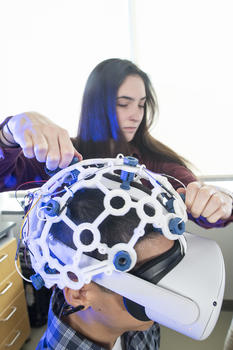Innovate for Good is a new ongoing series that examines how faculty in the College of Health and Human Services are improving health outcomes using technology such as artificial intelligence, virtual reality, and personal apps.
Part I: Reducing Caregiver Stress & Improving Recovery Cues

By its very nature, the practice of social work involves people. After all, the definition of social work is, essentially, people helping people. But in an era of artificial intelligence, virtual reality, and machine learning, technology is playing an increasingly central role in how people help people.
In George Mason University’s College of Health and Human Services, faculty members from the Department of Social Work are embracing technological innovation in its many forms to advance the practice of social work.
“In the field of social work, our goal has always been to figure out how to help those in our communities, whether through practice, organizational leadership, or policymaking,” said Emily S. Ihara, chair of the Department of Social Work. “What’s new is that we’re looking at fresh ways to gather more data to assess how we can best and most efficiently create social change.”
Innovate for Good begins with two ways researchers are using apps and virtual reality to improve the lives and health of those they work with.
Managing and Minimizing Caregiver Stress with a Phone
Caregiver burnout? There’s an app for that.
Funded by a Virginia Center on Aging, Alzheimer’s & Related Diseases Research Award Fund (ARDRAF) grant of $45,000, Ihara and Cathy Tompkins, professor of Social Work, are working with developers Ram Balasubramanian and Atreya Chaganty to help those who provide care for people living with dementia.
They are evaluating use of an app called Zelar developed by health care company Mantrah. This app will be geared toward caregivers with the intent of helping them manage the care of both the dementia patients they help and themselves.
“Care partners are often overwhelmed,” said Ihara. “The idea is that caregivers will enter information about different aspects of the care plan and they will be given reminders and helpful tips to provide organization.”
The app will have several features, including care plan creation, the ability for collaboration with other caregivers, plus self-care plans, a journaling option, and insights that provide feedback to caregivers on their reported performance.
“We’re trying to see if we can use technology to reduce caregiver stress,” said Ihara.
The project, Managing Mental Health Through Technology: Examining the Effects of Collaborative Care Management Technology Application, is being developed with Mantrah.
“In the field of social work, our goal has always been to figure out how to help those in our communities, whether through practice, organizational leadership, or policymaking. What’s new is that we’re looking at fresh ways to gather more data to assess how we can best and most efficiently create social change.”
Emily S. Ihara, Chair of the Department of Social Work
Harnessing the Power of Recovery Cues with Virtual Reality
A multidisciplinary team of researchers, working across four colleges and centers at Mason, is using technology to develop customized, real-time recovery supports to prevent drug relapse.
The research team is made up of Holly Matto in the Department of Social Work, along with Padmanabhan Seshaiyer in Mason’s College of Science, Stephanie Carmack in Mason’s Center for Adaptive Systems of Brain-Body Interactions, Nathalia Peixoto in Mason’s Volgenau School of Engineering, Siddharth Bhattacharya in Mason’s School of Business, plus graduate students in engineering Vinicius Zanini and Bryce Dunn and in social work Cate Feldkamp, as well as Rudra Nagalia, a Mason intern and student at the Birla Institute of Technology and Science, in Pilani, India.
The team hypothesizes that they can disrupt the drug trigger-craving-relapse cycle by reorienting people to what is personally rewarding in their lives and regulating the brain and body’s response to drug triggers. These are known as recovery cues.
This idea was inspired by Matto’s work in the field of addiction and from the lived experiences of people in recovery. After treatment, individuals often go back to the same environments that trigger a desire to use drugs, resulting in a need for ongoing, consistent support.
“Because craving can still be quite intense even after months of abstinence, real-time interventions to support recovery are essential to preventing relapse long-term,” said Matto. Examples of recovery cues include music, soundscapes, inspirational quotes, and more.
The Mason team and its industry partner, Brightline Interactive, are examining the effects of recovery cues using virtual reality simulations. The work is being supported by a grant from the National Institutes of Health’s National Institute on Drug Abuse through a Small Business Technology Transfer (STTR) Grant.
“Rather than focusing on drug triggers, our team believes that by focusing on the rewarding parts of their lives, their recovery cues and supports, individuals in recovery can strengthen and grow,” said Matto.
Virtual reality is unique among other technological enhancements in that it can recreate some elements of the social situations and physical environments that typically trigger relapse, allowing patients to practice skills they will need when they encounter such situations in real life.
Along with investigating recovery cues using virtual reality, the team is developing their Recovery Engaged Mind (REMind-h) app. In this app, individuals in recovery will be able to upload their customized recovery cues according to their preferred sensory modality (visual, auditory, tactile) and content category (people, places, objects), and be able to access these cues when experiencing intense craving.
Innovate for Good is an ongoing series that examines how Mason faculty in the College of Health and Human Services are harnessing technology to improve health outcomes.
